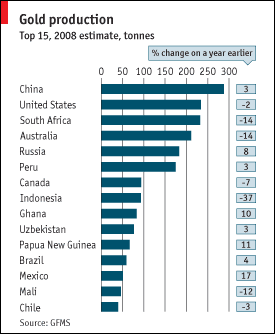– Platinum Soars As Spreading South African Miner Strike Cripples World’s Biggest Platinum Firm (ZeroHedge, Sep 12, 2012):
Ten days ago, when describing the latest casualty of the ongoing South African miner revolution, we said: “Expect more South African mines to shutter, as gold production in the world’s third largest gold producer grinds to a halt, and the local workers grasp they had the leverage all along. Should the South African example spread to other countries, then expect the price of gold to soar regardless of how much printing the central planners engage in the coming weeks and month.” Fast forward to today: “Labour unrest sweeping across South Africa’s mining sector hit top world platinum producer Anglo American Platinum on Wednesday, with striking miners blockading roads leading to shafts belonging to the mining giant, police said. The platinum price jumped as much as 1.5 percent to $1,624.74 an ounce, its highest since mid-April amid fears of more disruption to supplies of the precious metal used in jewellery and vehicle catalytic converters.” The good news: the complete mining shut down has not spread to other countries. Yet. The bad news: as expected, one after another South African mine is going offline. Why is this an issue? Because Chinese demands is soaring, even as the world is about to lose its third largest producer of gold. Not even the CME hiking gold margins to infinity will do much to prevent what will inevitably be a surge in precious metal prices. Factor in what is likely to be more easing by Bernanke tomorrow, and it may be time to eye the all time nominal high of just over $1,900 gold hit a year ago.
From Reuters:
South Africa is home to 80 percent of known reserves. The platinum price has jumped more than 17 percent since police shot dead 34 protesters at the Marikana mine of world No. 3 platinum producer Lonmin on Aug. 16, the bloodiest security incident since the end of apartheid in 1994.
The “Marikana massacre” has poisoned industrial relations across the mining sector and become a potent symbol of the ruling African National Congress’ (ANC) failure to deliver on promises of a “better life for all” in the post-apartheid era.
The bloodshed and the government’s inability to ease unrest undermining already shaky growth in Africa’s biggest economy is also fuelling a campaign against President Jacob Zuma, who faces an internal ANC leadership battle in December.
“Around 1,000 mineworkers had a confrontation with mine security last night at the Siphumelele shaft and the situation has spread to other mine shafts this morning,” regional police spokesman Thulani Ngubane said of the trouble at Amplats.
He declined to give any details of the size of the security operation, the latest police deployment in more than five weeks of union violence in the “platinum belt” around Rustenburg, 100 km (60 miles) northwest of Johannesburg.
Amplats’ four Rustenburg mines represent almost 17 percent of total production by the company, which accounts for 40 percent of world platinum output. They employ more than 19,000 people.
The strikes, which stem from a challenge by the small but militant Association of Mineworkers and Construction Union (AMCU) to the dominance of the ANC-affiliated National Union of Mineworkers (NUM), are also spreading into the gold sector.
The NUM said workers at the Beatrix mine, run by world No. 4 producer Gold Fields were set to strike this week, compounding wildcat industrial action this week by 15,000 workers at the company’s KDC West west of Johannesburg.
ANC renegade Julius Malema – the de facto face of the unofficial ‘Anybody But Zuma’ rebellion in the ANC – is also fanning the flames, appearing twice at KDC to speak to striking workers. He called on Tuesday for a national mining strike.
Hopefully events like those above should explain whyprecious metal miners and the underlying commodity have now terminally disconnected, because in this, and all future cases, Anglo American’s loss is platinum’s gain. Extrapolate to other metals.
The open question is how soon until the South African labor disputes spread to other gold miners.
